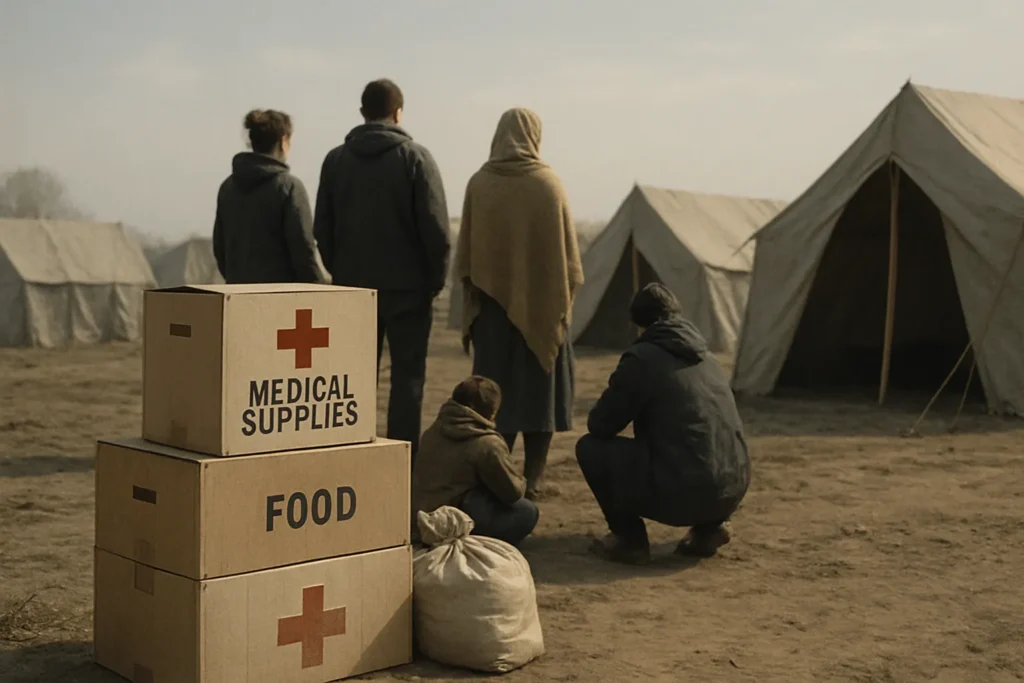Aid Turned Deadly: Scenes from Gaza’s Humanitarian Nightmare
In the early hours, as the sun pushed through the haze that now masks much of Gaza’s skyline, another tragedy unfolded—one that has become all too familiar to Palestinians and the world watching in anguish. At least 22 Palestinians lost their lives and 20 more were wounded when Israeli forces opened fire near humanitarian food aid distribution sites. For the families clutching ration cards and hope outside the Gaza Humanitarian Fund (GHF) hub in Khan Younis, the day had begun with the faint promise of filling hungry bellies. It ended in bloodshed and chaos.
Eyewitness accounts paint a harrowing picture. Yousef Mahmoud Mokheimar, shot in the leg, remembers the sound of warning shots—then the panic, as live rounds swept indiscriminately through the crowd. “They fired over our heads, and people started running. That’s when the bullets came for us,” he told local reporters from his hospital bed. Mokheimar also saw six others, including three children, rounded up and detained by Israeli troops; their fate, an unanswered and chilling question.
Beyond Khan Younis, the violence reached even places long considered neutral ground. An Israeli strike on a United Nations aid warehouse in Gaza City killed ten more. The question lingers: even as the world’s eyes turn to humanitarian convoys, why do the most vulnerable pay the heaviest price?
Systemic Risks, Controversial Programs: U.S. and Israel Reshape Gaza Aid
Compounding the tragedy is the bitter controversy surrounding the Gaza Humanitarian Fund, a food aid program backed by both Israel and the United States. Intended to address mounting starvation, the GHF model replaced United Nations-led systems with Israeli-approved distribution routes, fencing, and a heavy military presence. But the consequences have been dire: according to Gaza’s Health Ministry and international aid observers, over 500 Palestinians have died while attempting to access aid in just the past month.
Israeli military officials justify their actions by claiming that warning shots are only fired when individuals display suspicious behavior or approach sensitive security zones. But for families forced to travel miles, often along a single route flanked by rubble and checkpoints, these protocols are cold comfort. A closer look reveals a system where desperation meets militarization—where safeguarding humanitarian logistics has too often devolved into lethal encounters.
Dr. Sara Roy, a Harvard scholar with decades studying Gaza’s economy and society, argues that these deaths are not mere accidents: “The increasing fusion of humanitarian aid with military strategy invites inevitable harm and erodes any semblance of neutrality that international law demands.” The Israeli government, meanwhile, insists that its hands are tied by security concerns and accuses Hamas of manipulating or diverting supplies.
Systemic indifference to Palestinian suffering remains entrenched, visible not just in gunfire but in the labyrinthine journey required to simply feed a family. Routes to aid centers stretch across razed neighborhoods; checkpoints snarl the flow of both people and supplies. In the words of families outside the GHF distribution hubs, a daily equation emerges: how much risk will you accept for a bag of flour or a can of beans?
Global Outcry and The Fight for Accountability
The international response has oscillated between outrage and impotence. The United Nations repeatedly urges Israel to safeguard humanitarian corridors, with Secretary-General António Guterres warning that “This is not aid. This is survival staged as a lottery between life and death.” Human Rights Watch and Amnesty International have demanded independent investigations into both the incident at the Nasser Hospital in Khan Younis and the attack on the U.N. warehouse in Gaza City; so far, Israeli authorities maintain they are internally reviewing the events.
“When seeking food becomes a calculated risk of being shot, the humanitarian mission’s very meaning is lost. The world must not look away from Gaza’s slow-motion catastrophe.”
So, who bears responsibility? According to recent polling by Pew Research, public opinion in the U.S. and Europe increasingly supports robust international oversight over crisis aid in Gaza—most Americans believe U.S. policymakers should demand stronger protections for civilians over alignment with Israeli policy. This tension is reflected on Capitol Hill, where progressive lawmakers decry the mounting civilian toll and press for strict conditions on military and humanitarian assistance to Israel.
Historically, moments like these challenge the conscience of democratic societies. Images from Jerusalem in 1948, from Sarajevo in the 1990s, and now from the shattered districts of Gaza, remind us that the test of humanity is not power but our willingness to protect the powerless.
What will it take for leaders to prioritize the sanctity of life over military expedience? As the aid crisis drags on, the risk is not just the erosion of Palestinian lives but the moral standing of international actors complicit or complacent in this grim calculus. The need for an urgent course correction is clear. As Guterres recently underscored, “Civilians must be shielded, not sacrificed.” The call for accountability and justice must move from slogans to policy, from platitudes to action—lest headlines like these become the unbearable norm.

